low quality drawing to 3d model
At the beginning of a project, choose a file format that tin can comprehensively describe the design while suiting the intended applications and minimizing the need for file conversions. Meshmixer will read numerous 3D file types, such as STL, OBJ, PLY, and some lesser known formats; AMF, 3MF, OFF, and the native MIX format. For exporting designs to a different format, Meshmixer also supports Collada, VRML, and Smesh.
- STL (STereoLithography) is a format originally adult for stereolithography 3D printing that is the almost normally accepted file format in 3D printing. It stores simply geometry data and has a meaty file size.
- OBJ as starting time created past Wavefront is a uncomplicated format storing vertex information to represent a 3D mesh. Besides vertex positions, it also stores surface normal plus a UV coordinate that can exist mapped to an external texture.
- PLY (Polygon) is a more than all-encompassing format developed at Stanford to aid the storage of 3D scanning data. 1 of its benefits is the possibility to assign backdrop such equally texture data separately for both sides of a face.
- AMF (Additive Manufacturing Format) is an alternative to STL for 3D printing. Being XML-based, it will shop additional data such every bit orientation, calibration, patterning multiple objects, non-planar edges, and graded materials.
- 3MF (3D Manufacturing Format) is like to AMF just less standardized every bit information technology is created by a consortium of companies. Originally adult by Microsoft, it is the native 3D format in Windows.
- OFF (Object File Format) is a uncomplicated, hand-programmable, text-based format that side by side to geometry also stores color information per vertex.
- Collada (COLLaborative Pattern Activity) is a versatile format well-suited for digital assets that was developed past Sony. The now widely supported format allows developers to store rendering information such as animations, level-of-detail, shaders, as well as diffuse, normal and specularity maps.
- VRML (Virtual Reality Markup Language) is similar to Collada but scriptable and compatible with web browsers.
- Smesh is a simple format that describes 3D geometry both in terms of triangles and complex polygons. This makes the format more suited for objects with large planar areas.
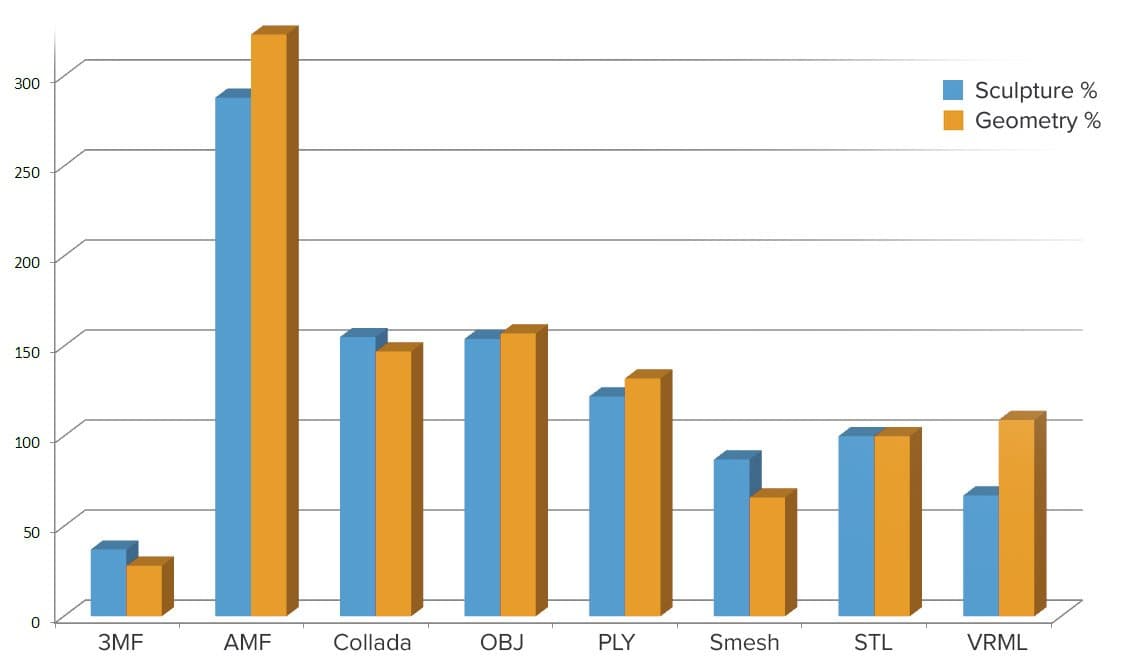
A comparison to the standard STL file format for sculptural and geometrical files reveals that 3MF and Smesh are more than effective formats, while AMF is more versatile, only also more expensive space-wise.
Before modifying a part, brand sure to optimize its triangulation. In our example, nosotros picked a model of the Venus of Milo that has an uneven distribution of triangles plus some separate and complanate triangles. With Meshmixer, y'all can create an even tessellation using the Remesh command.
Click the Select Icon in the carte du jour and click to create an surface area to be remeshed, or employ Ctrl + A to select the entire object. On the Popup menu, click Edit → Remesh or hit R. There are several Remesh Modes:
-
Target Edge Length ensures an even triangle size across the mesh, optimizing the part for sculpting. This is computationally intensive so prepare a reasonable size relative to the object.
-
Relative Density is the aforementioned method but specifies according to triangle density.
-
Adaptive Density creates a denser triangulation in more detailed areas, optimizing file size. This is helpful when the object is complete and can be saved for 3D printing.
-
Linear Subdivision simply creates more than triangles past splitting existing ones, maintaining the original geometry.
Note that the Regularity setting creates more than equilateral triangles but sacrifices more item. The Transition setting creates a gradual transition from the original mesh to the remeshed section. With Preserve Grouping Boundaries checked the program maintains the shape of specifically designed triangle groups such equally perfectly circular eyes. Checking the Preserve Precipitous Edges option prevents hard corners from beingness smoothed out. Under Purlieus, a Free Boundary is ofttimes preferred because it sacrifices accuracy for mesh quality.
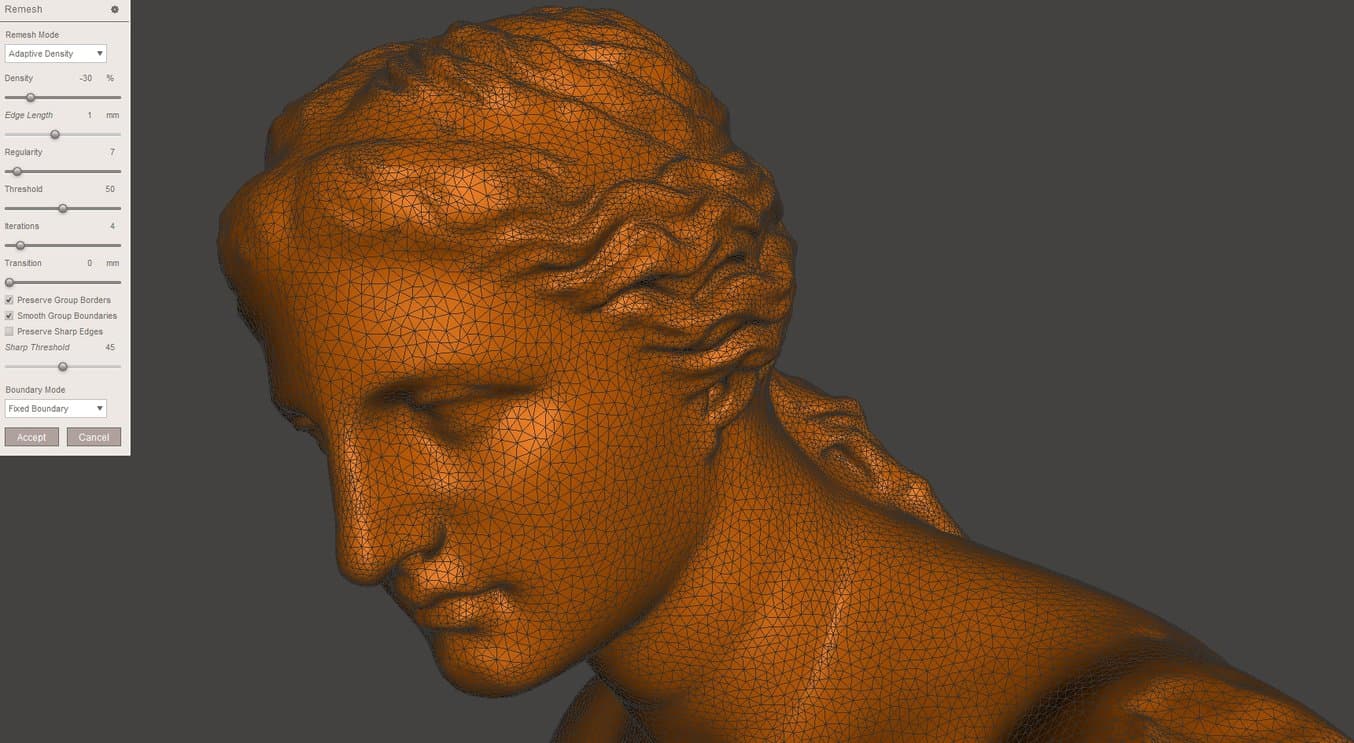
Optimizing the mesh reduced the file size by 60%.
Meshmixer offers several means to split up a part of a mesh. The simplest method is beginning selecting the role to exist separated, and then using the Edit → Excerpt (Shift+D) control. The plan will create a new vanquish with an optional starting time altitude. Choosing the Normal direction for the offset will aggrandize or shrink your part. And so, from the main bill of fare, choice Edit → Divide Shells to individually save and proper name each role, while deleting obsolete sections.
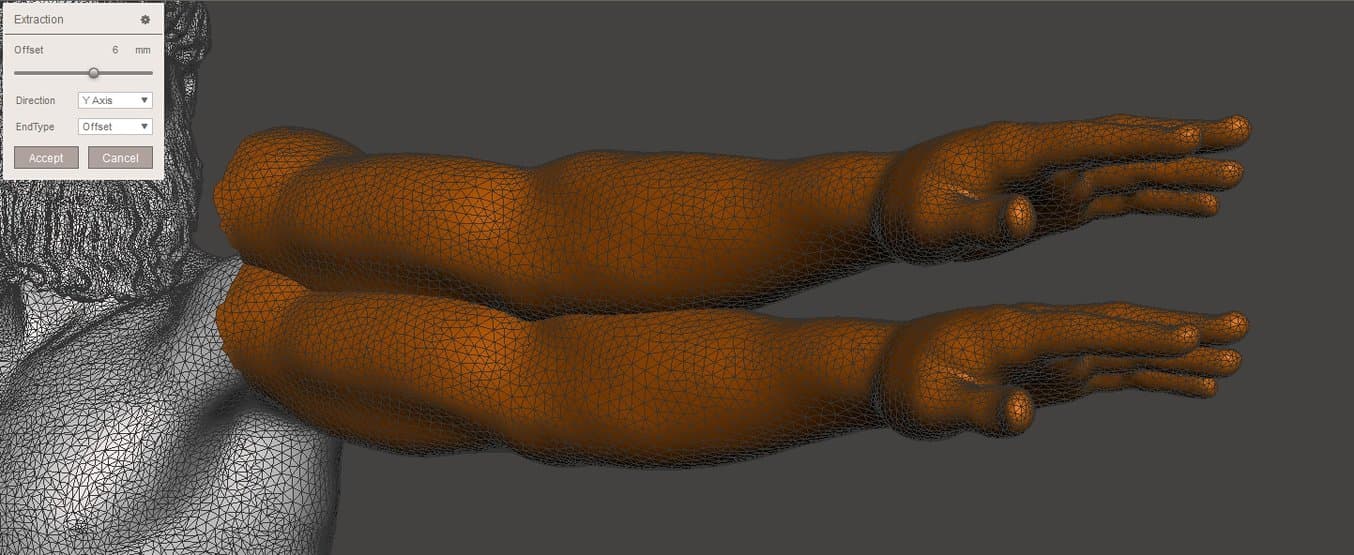
The Excerpt command creates a duplicate or offset of a selected area.
The other method is Edit → Airplane Cut. This brings up a transform gizmo assuasive orientation of the cutting plane. The blue pointer is used to specify cut direction. In instance a plane would cut off unwanted sections, information technology is possible to create a option prior to cutting. With the selection active, hit Edit → Plane Cutting from the pop-up rather than from the chief carte du jour.
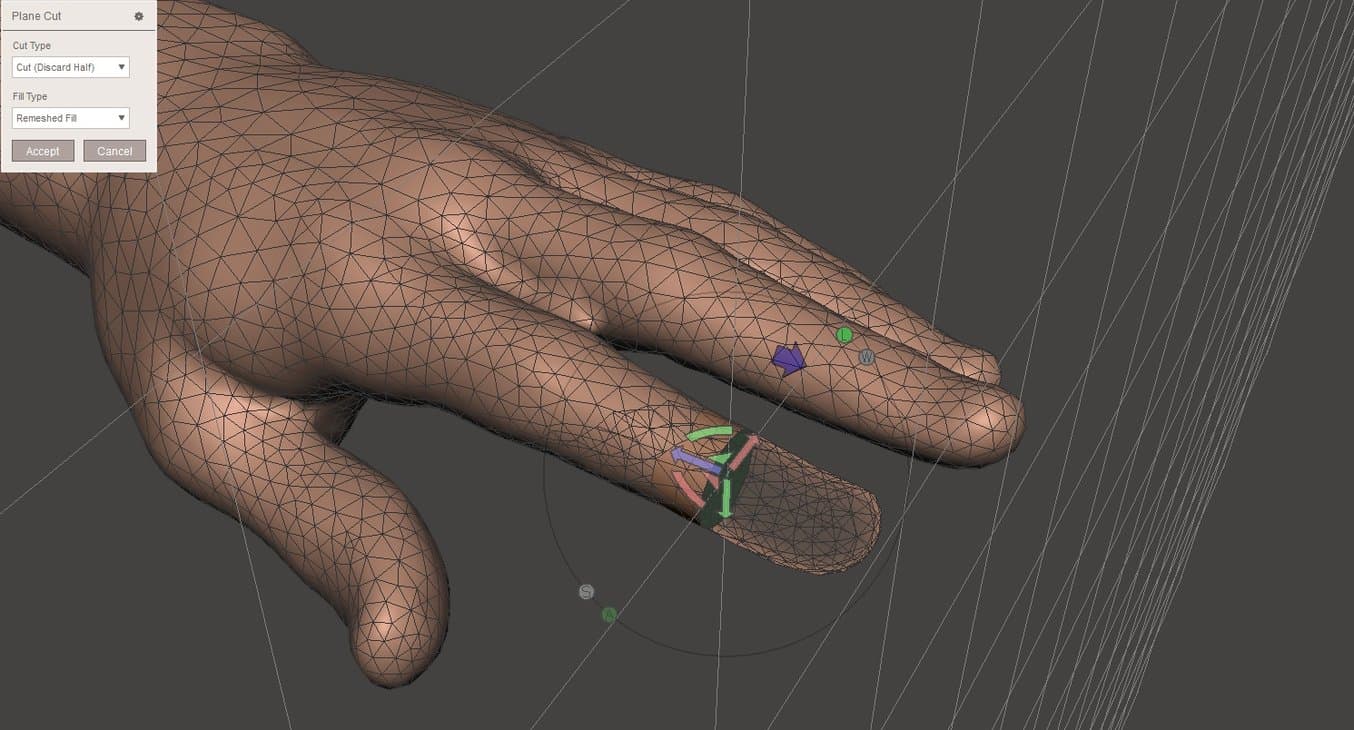
The Plane Cut command applied to a selection cuts off a specific surface area without affecting others.
Meshmixer was originally created to interchange and combine different 3D parts. On opening the programme, the first icon Meshmix opens upwards a library of parts. Under the dropdown menu is a section called My Parts. This allows users to create a custom 3D library.
To add an object, select it in the object browser (toggle with Ctrl + Shift + O), and then select all with Ctrl + A. Now in the Select department of the master menu choose Convert to → Solid Part. Later on hitting Take the object will be visible in the My Parts section.
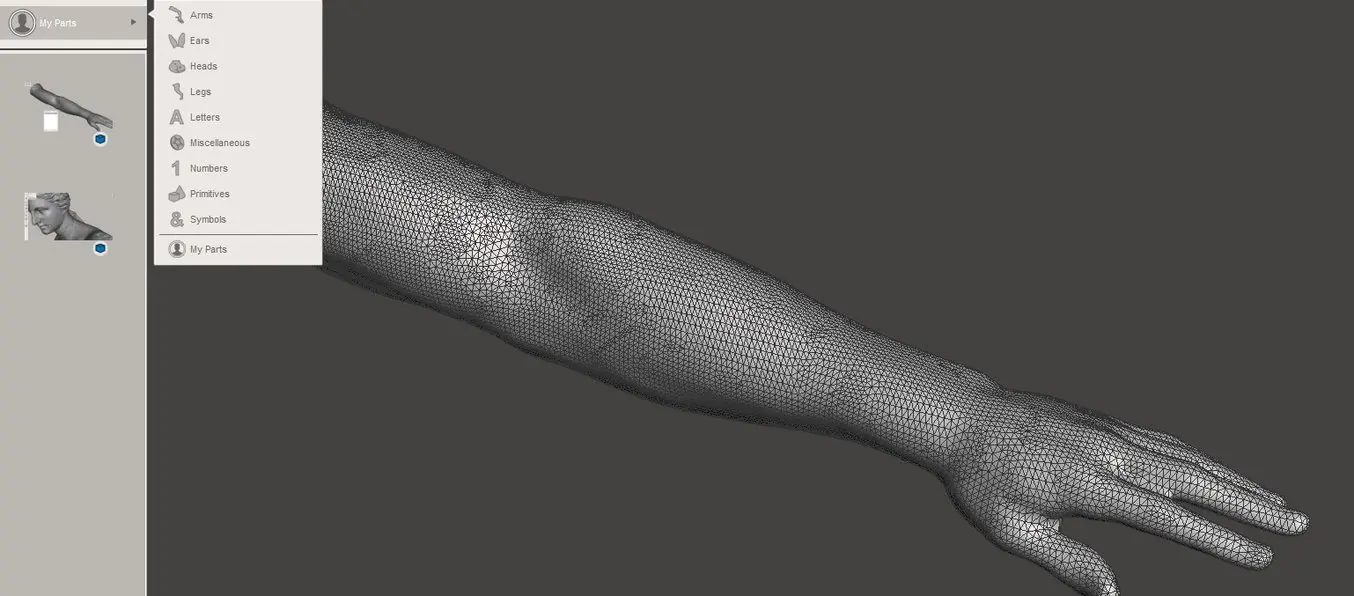
My Parts lets users create a custom object library.
In the Sculpt section, Meshmixer offers several brushes that can be applied directly to the mesh. The post-obit Book brushes offer all the functionality required for bones 3D sculpting work:
-
Drag moves an expanse in 3D infinite
-
Draw displaces vertices forth the normal of the brush region, every bit if drawing on the surface
-
Flatten moves vertices in the brush region towards the average normal of that area
-
Inflate translates vertices forth their normal
Drag moves an expanse in 3D space
Describe displaces vertices along the normal of the brush region, as if drawing on the surface
Flatten moves vertices in the brush region towards the average normal of that surface area
Inflate translates vertices along their normal
Property Ctrl while sculpting inverts the brush function, i.due east., deflating instead of inflating and debossing instead of drawing. Quickly change castor size with the straight bracket ( [ and ] ) hotkeys, or cycle through last used brushes with the left and right arrows. The recommended secondary brush is RobustSmooth which is activated past holding Shift. This fashion, the sculptor can rapidly alternate between manipulation and smoothing brushes to define the overall volume.
For calculation detail, the Draw brush with a spiky falloff design works well. Together with the Pinch brush, this results in very precipitous lines. Surface brushes are great for adding particular equally well. The use of custom stencils allows rapid creation of intricate textures. Brand sure to Enable Refinement (hotkey R) or use the Refine Brush in the Volume section to add triangles for additional item.
Checking Symmetry (hotkey Shift + Due south) applies the identical sculpting operation across a symmetry plane. When checked, hit the toolbox icon next to the command to manually identify the symmetry plane.
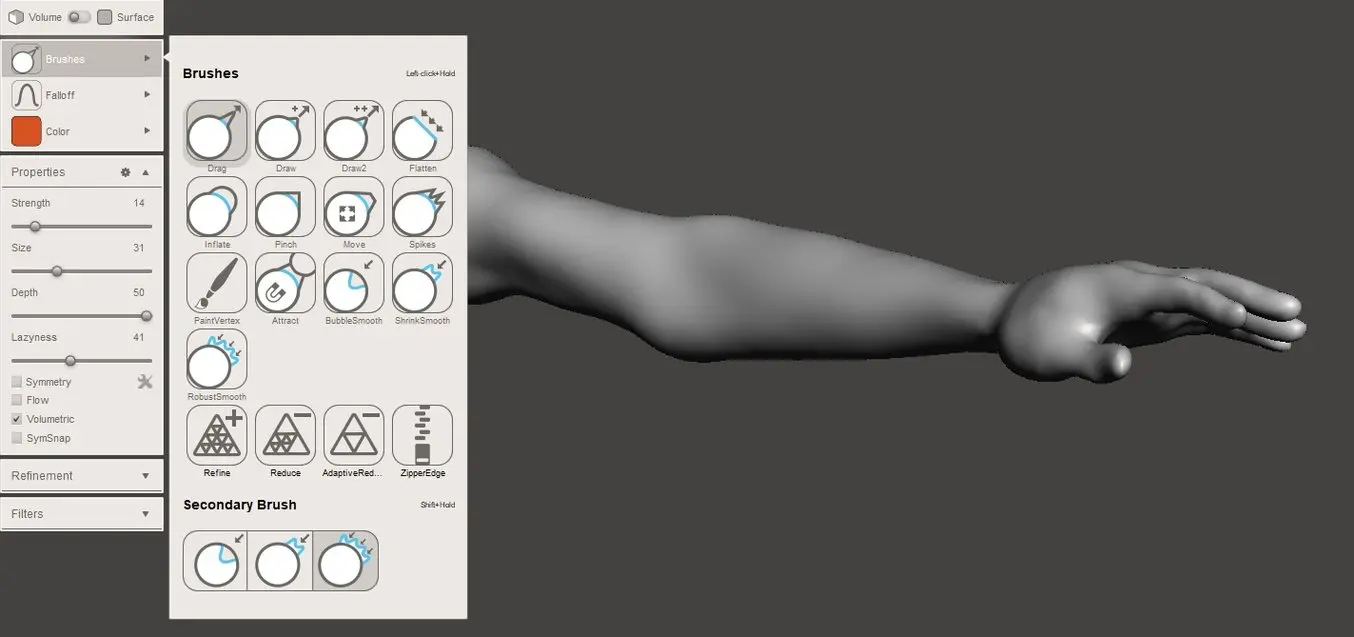
Basic volume brushes transformed this arm model into a softer i that will fit our Venus of Milo model better.
To combine two meshes into 1, import both meshes or drag them from the Meshmix library. In the Object Browser, select an object from the main card and cull Edit → Transform to position each object. With both objects selected, start the appropriate Boolean command, in this instance, Union. This is a complex algorithm that merges the ii objects into a single shell. In case the object consists of multiple shells, first utilize the Edit → Separate Shells command. For a Boolean Difference command, the second selected object is subtracted from the first. Because of Meshmixer's unique version of the Boolean script, information technology not but works on solid models but also on surfaces.
Precise or Max Quality manner volition maintain the intersection curve between both objects, while Fast Approximate is much quicker and usually suffices. If the Boolean operation fails information technology results in two crimson colored objects. In that example, turn the Search Depth parameter up to increment the hazard of success. Checking Employ Intersection Curves also improves quality. Target Border Scale controls the size of the triangles near the intersection relative to the surrounding ones.
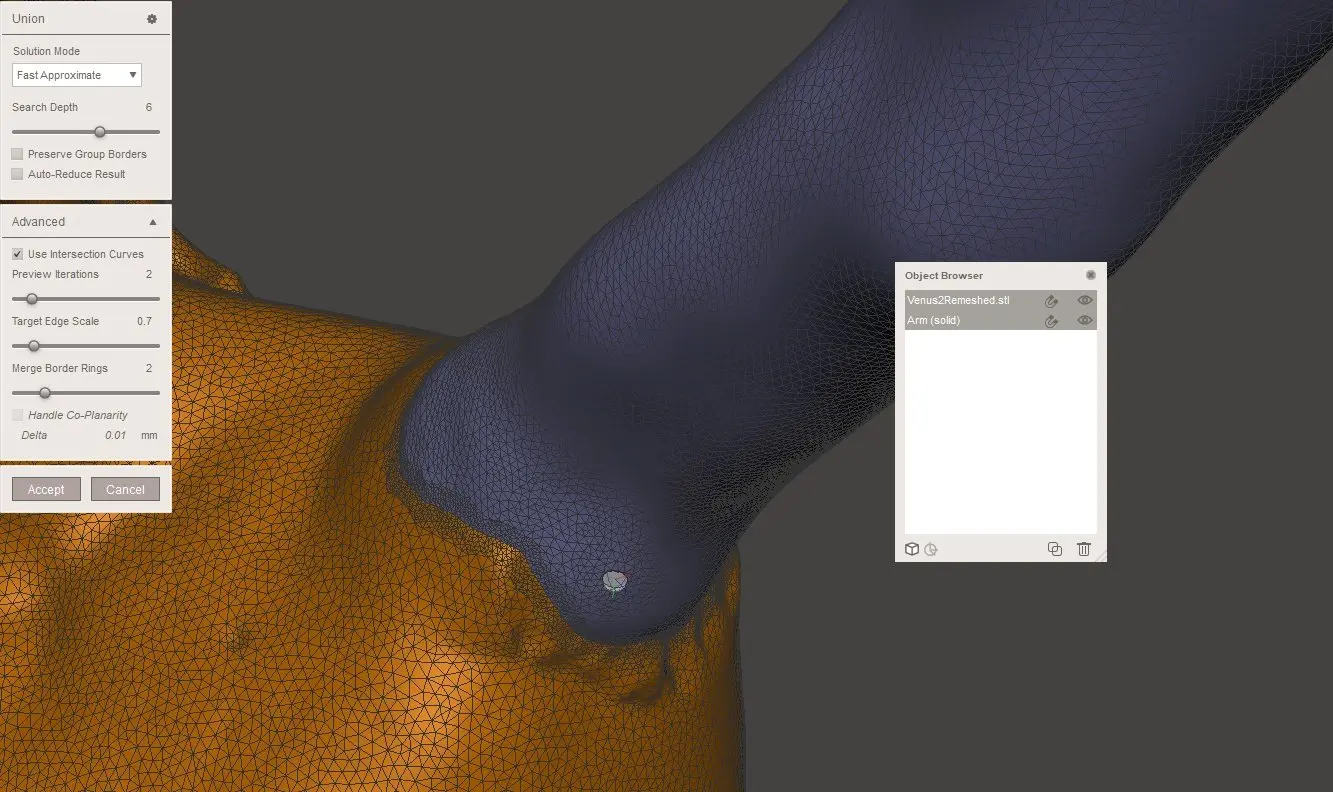
A successful Meshmix with added detail at the intersection for resculpting.
Meshmixer offers several advanced ways of patching upwardly holes in a mesh. Sometimes it is useful to create a hole in gild to cut out an irregular expanse. In that example, enter Select mode and use the lasso to select the area to be removed. Now hitting Delete or Edit → Discard (X) to remove all selected faces. Go to Analysis → Inspector and the pigsty will be detected. Of the available options in the dropdown menu, Minimal Make full results in the to the lowest degree amount of triangles necessary to close the hole. A Apartment Fill creates a patch as apartment every bit possible, and a Smooth Make full matches the patch to the curvature of the surrounding surface area. Auto Repair All usually fixes all holes, every bit well as intersecting and floating triangles.
An alternative method is to select the area to be deleted and use the Edit → Erase and Make full (F) operation from the popup menu. Setting Type to Smooth MVC results in a practiced continuous fill. Edit → Brand Solid or Edit → Supplant and Fill are other methods that will fill all holes. An additional laissez passer with the RobustSmooth sculpting brush will blend the improved surface area completely into the model.

Smoothing out irregular areas.
For any feature to be visible after 3D printing, information technology needs to accept a minimum wall thickness or particular size, that'due south dependent on the 3D printer and 3D printing engineering science. Stereolithography 3D printers, like the Class three, can reproduce some of the finest details.
One way to add thickness to a mesh lies in a specific use of the Extrude command. Select the area that needs thickening using Brush mode, which allows selecting (and deselecting by holding Ctrl) individual triangles. It is possible to smooth the selection by choosingChange → Polish Purlieus from the popup carte. Increasing the Smoothness and Iterations parameters will result in a more than clean selection. Now, choose Edit → Extrude (D) with Normal as the Direction setting.
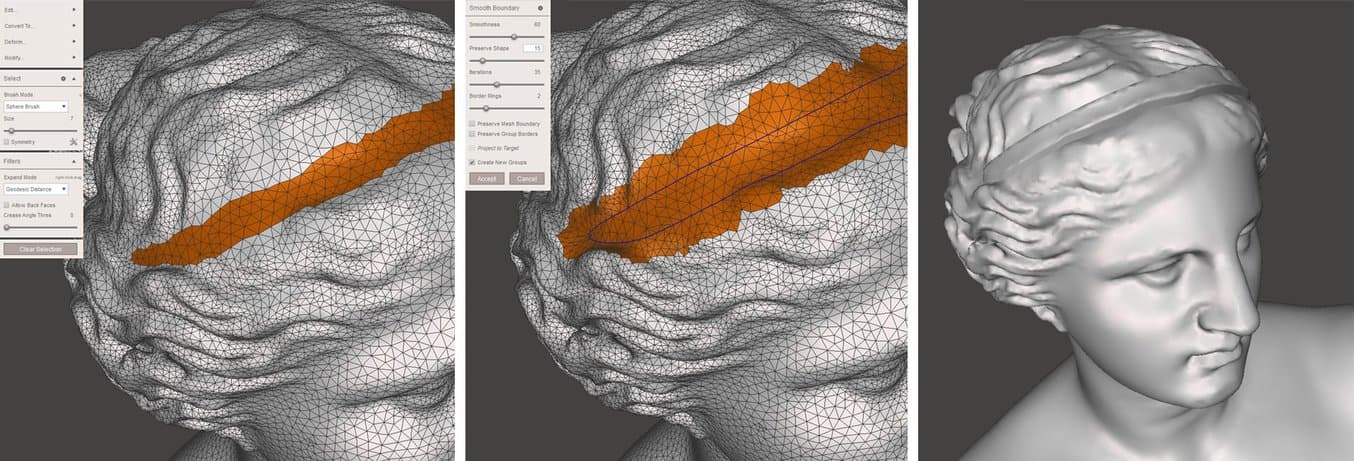
Generating a thicker section with the Extrude performance.
At times when you're non printing functional parts that require a certain strength, calculation wall thickness to hollow out your design tin can be a keen style to save a considerable amount of fabric and time.
To install a wall thickness to the entire model, cull Edit → Hollow. The minimum wall thickness depends on the 3D printing technology. For both SLA and selective laser sintering (SLS), i mm is a good minimum offset value.
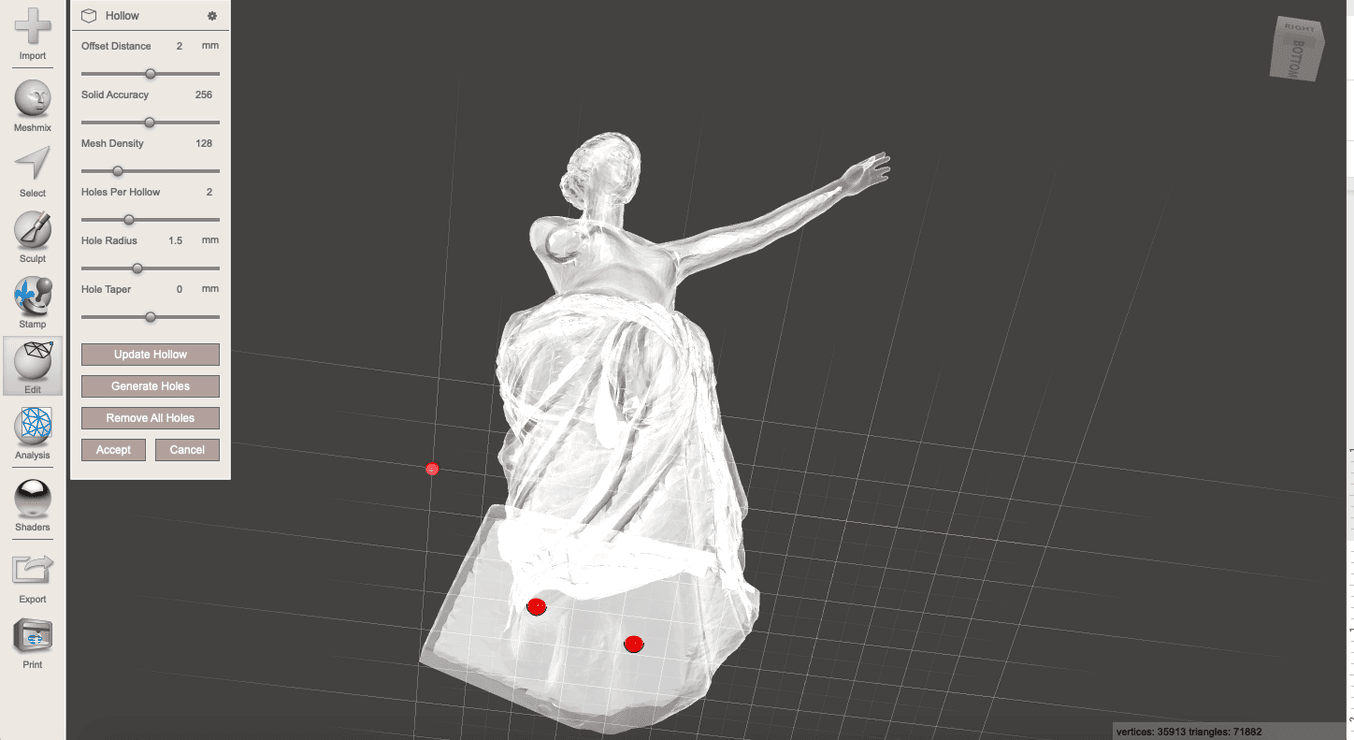
Adding escape holes when hollowing out parts is crucial for successful 3D printing with SLA and SLS technologies.
For SLA, include at least two holes with one.5 mm diameter—1 closest every bit possible to the build platform, the other somewhere on an opposite side. This provides an escape pigsty for the resin, preventing a pressure differential during the 3D printing process. Information technology too ensures good isopropyl alcohol (IPA) menstruation during cleaning and air venting subsequently.
For SLS models, add two 2 mm holes or one hole with a 4 mm diameter for the entrapped powder to escape. Information technology is possible to Generate Holes automatically or double-click to specify custom locations.
To ensure a watertight model, run Edit → Brand Solid after creating holes. This is an intensive operation then make certain the model is now ready for 3D press.
Using the Analysis → Stability tool nosotros can also conclude that the object volume has been reduced past more than than 75% in our example instance that'll significantly reduce textile apply and printing time.
Employ Analysis → Thickness to verify if the wall thickness of the model is within acceptable limits for the given 3D printing technology. Not sufficient wall thickness might lead to lost details, or, in a worse case, impress failure.
The Minimum Thickness setting checks if the wall thickness meets this dimension, and Minimum Defect Size indicates the minimum size the area needs to have to be marked as below the threshold. Cone Bending, Cone Samples, and Grazing Bending are technical parameters relating to the number of rays calculated from one side to the other and the bending between them in order to determine wall thickness. Lowering the cone samples and setting a higher grazing bending will improve processing times.
Analyzing our unmarried-armed Venus model, at that place are some areas of depression wall thickness, but with SLA 3D printing, only the largest ones on the tunic will need modification, for example using the Inflate castor.
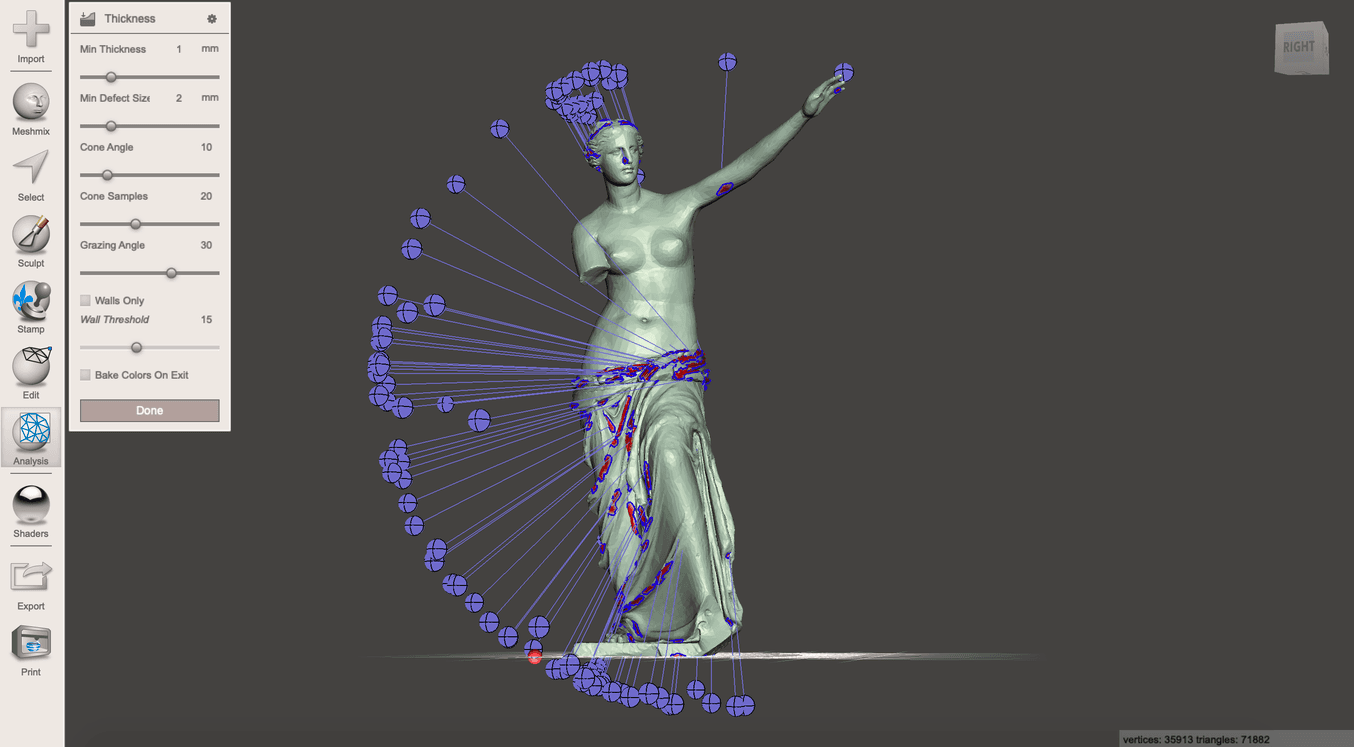
Wall thickness assay volition assistance to preserve details and reduce print failures.
Non surprisingly, our Venus sculpture was not created with 3D printing pattern rules in listen more than 2,000 years ago. For successful printing, fused deposition modeling (FDM) and SLA 3D printers will crave support structures. Meshmixer offers the possibility to embed back up structures directly into the mesh. They are synthetic using bifurcating strands that abound upward to the overhang, which can salvage plenty of material compared to raft-based supports.
Advanced print preparation tools like Formlabs' PreForm software permit you to create and edit optimal support structures with ease for the selected printer and 3D model. For all-time results, nosotros recommend using PreForm to create support structures. PreForm is free, try it at present.
From the chief menu, option Analysis → Overhangs and select a preset pertaining to the 3D printer. Calculation a Contact Tolerance specifies the distance from the tip of the support structure to the model in order to facilitate breakaway. At present open up the Support Generator that presents us with settings that speak for themselves. Nether Advanced Support brand certain to check Allow Tiptop Connections for models requiring alpine support structures. This volition create supports that offset somewhere on the model itself rather than starting from the build plate. Afterwards tweaking the settings, hit Generate Supports. The support generator is computationally intensive so for large models it is sometimes useful to perform another Edit → Remesh or Edit → Reduce operation to minimize triangle count. It also helps to take the model already positioned with the Z-axis upward and snapped to the XY-aeroplane. Utilize Ctrl + LMB to remove individual supports in areas of high detail where they might interfere with the product geometry, are prone to fail to print, or will be hard to remove post-printing.
With all back up structures in identify, Convert to Solid combines all connected supports into a single object. The Edit → Separate Shells command then allows saving back up structures separately from the model in social club to apply different 3D press settings in the slicer software.
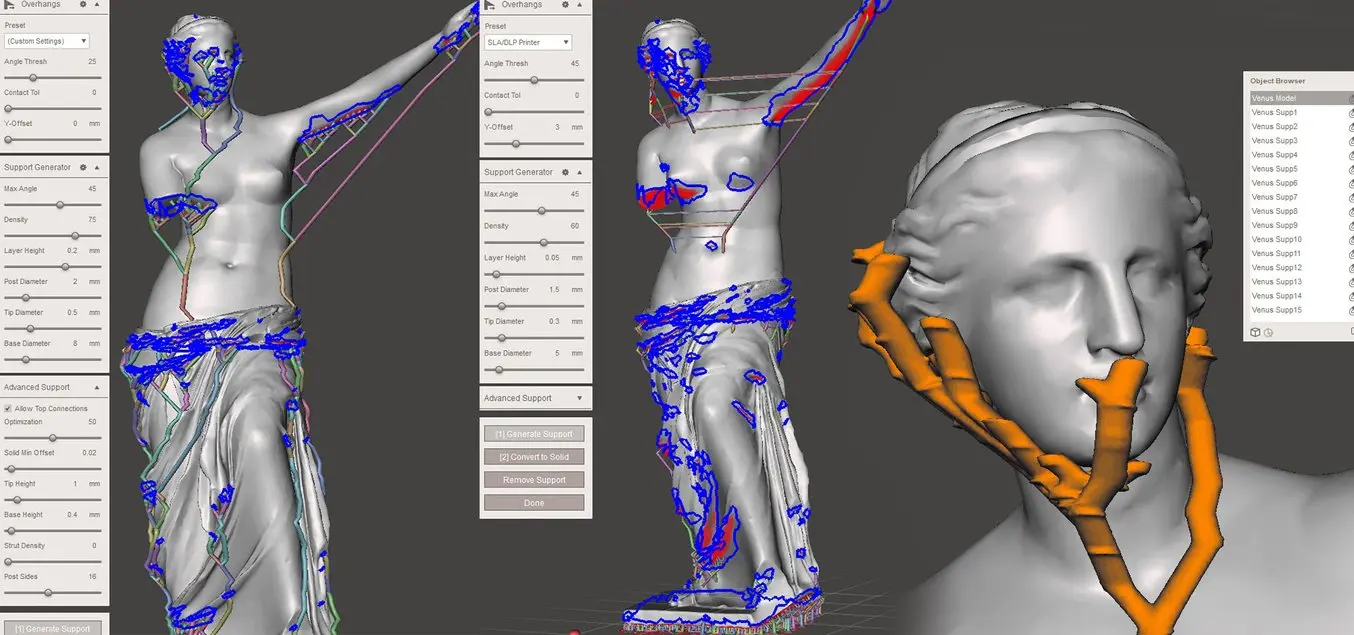
Support structures generated for FDM and SLA 3D press can bereduced to the bare minimum in highly detailed areas.
Adding wires to a 3D model, for example, for connecting multiple parts in a single print, tin can take substantial effort if done manually. Delegating this part of the modeling process to MeshMixer will result in a successful model when using the powerful Edit → AddTube tool. This allows the user to specify 2 points on the mesh surface betwixt which a tube of specified first and end radius gets connected. The Spline type allows curving the tube along the commencement and the cease face normal, with tunable tangent force. AutoRoute (Smooth) creates a tube that as far equally possible passes through the model which is useful for fluid channels or electrical wiring routes.
When choosing Boolean in Combine Mode, an outside tube is added to the mesh while an inside tube gets subtracted to create an internal aqueduct. Append creates a new shell within the same object without merging with it.
In instance we want to create an array of miniature objects connected past means of a sprue-type connection, Edit → Transform (T) and Edit → Mirror are useful to scale down and reposition them. With Edit → Align the object can exist snapped to the ground plane. Hit Edit → Duplicate and with the new object selected in the object browser, use the Transform tool to move it along the 10-axis. Select the ii objects and perform a Combine operation to motion the models into a single object and create linear patterns rapidly. For more avant-garde object patterning functions, information technology's all-time to utilize other software tools, such as Blender'southward Array Modifier.
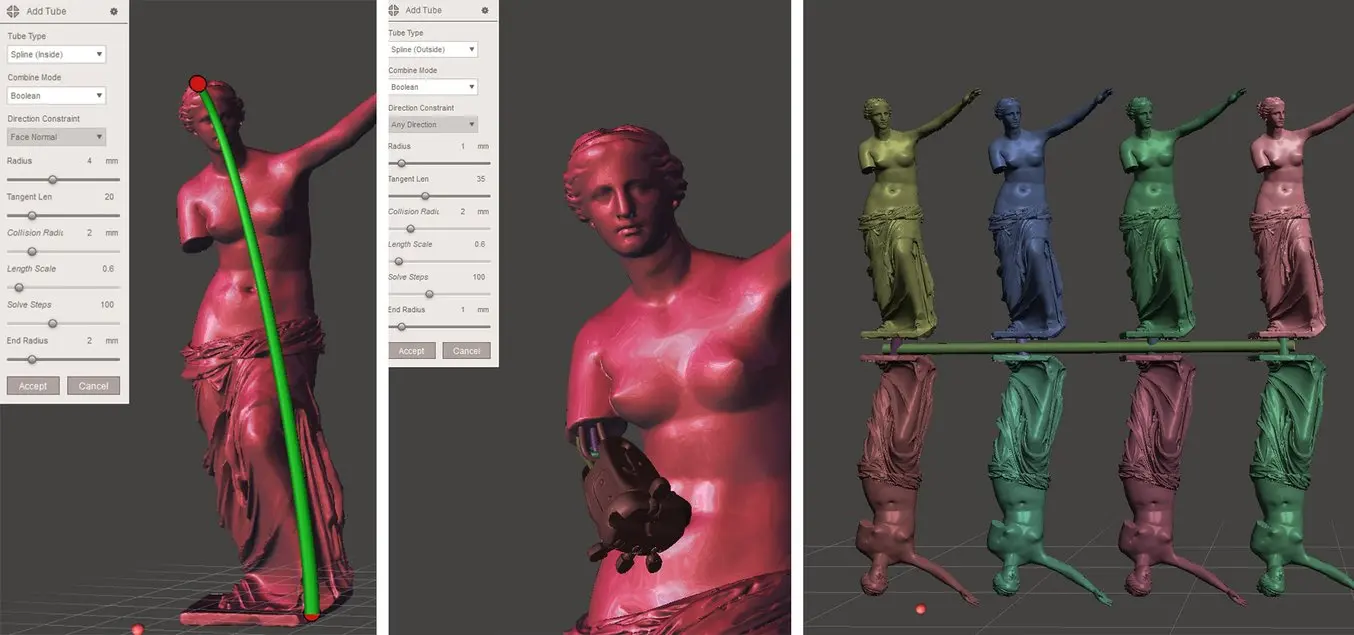
Unlike uses of the AddTube tool.
When printing multiple objects, it is important to make efficient utilise of the available space. MeshMixer offers the Analysis → Layout/Packing functionality to layout objects in different ways. It is of import to apply the Separate Shells command and correctly orient the objects relative to the ground aeroplane before starting the packing algorithm. For our Venus sculpture, a Square Packing Style proved more than efficient than a Circular Packing Style.
MeshMixer'south Packing algorithm optimizes the layout to save space when 3D printing multiple objects.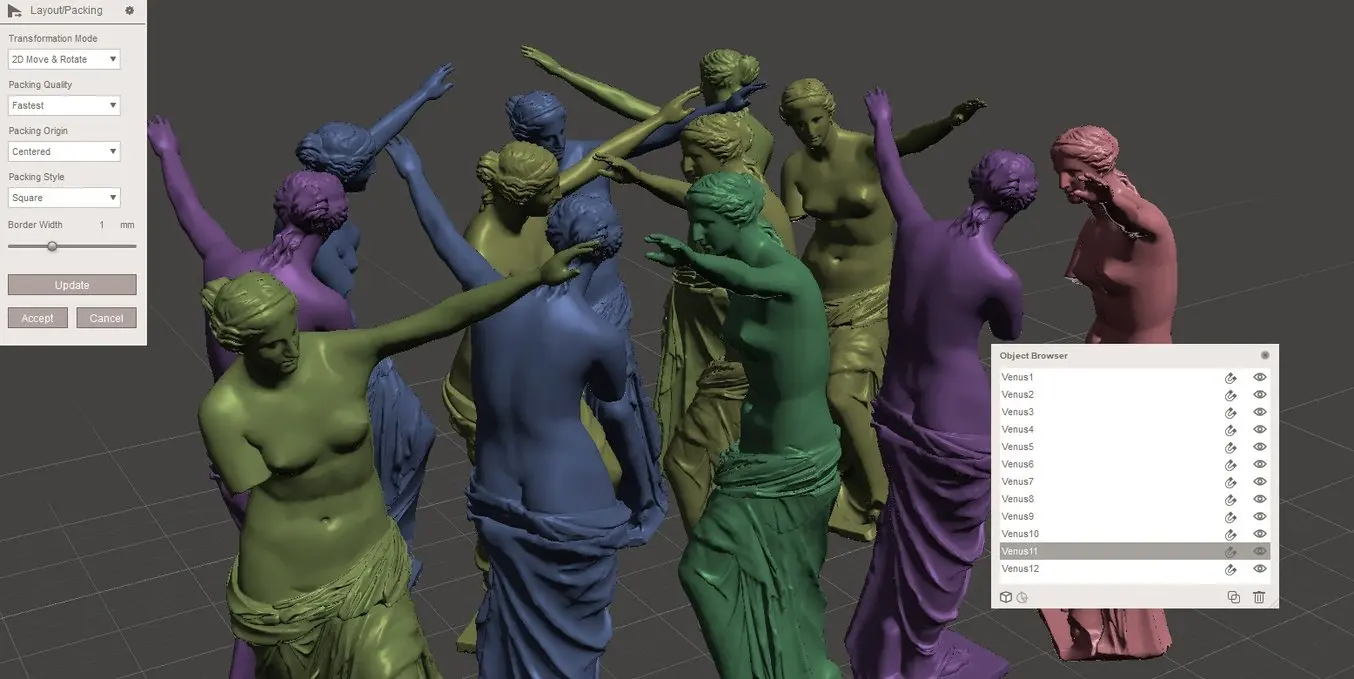
Meshmixer also features a listing of stylistic variation to allow designers to get creative when editing meshes.
Voxelize
The Edit → Make Solid command from the main menu creates a watertight solid from mesh surfaces past recomputing the object into a voxel representation. If we opt for Blocky manner under Solid Type with large cell size, it results in a funky voxelized model. To preclude direct overhangs that need support structures, the flim-flam is to start rotate the object by 45 degrees over the X or Z-axis using the Edit → Transform tool. Use Edit → Plane Cut to brand the lesser apartment over again.
Low Poly
Making skillful low polygonal models is an fine art that ofttimes requires many hours of transmission pattern work. MeshMixer provides avant-garde functionality to plough even complex objects into striking depression poly pieces. This tin can exist done in 2 passes:
-
First, determine the minimum triangle size necessary to preserve particular. This removes unnecessary detail which speeds upwards experimentation in the 2nd pass. Click Edit → Remesh and choose Relative Density way. Turn downwardly the Density slider to where the geometry is still reasonably represented, with the Preserve Abrupt Edges pick left unchecked.
-
Striking Have and over again choose Edit → Remesh. This time, use the Target Border Length mode to specify the length of the longest edge required in the low poly model nether Edge Length. Now check Preserve Sharp Edges and experiment with the Sharp Threshold and Regularity parameters until the model looks like an artistic version of the original one.
First, determine the minimum triangle size necessary to preserve detail. This removes unnecessary item which speeds up experimentation in the second laissez passer. Click Edit → Remesh and cull Relative Density mode. Refuse the Density slider to where the geometry is still reasonably represented, with the Preserve Sharp Edges option left unchecked.
Hit Have and again cull Edit → Remesh. This fourth dimension, utilize the Target Border Length mode to specify the length of the longest edge required in the low poly model under Edge Length. Now check Preserve Abrupt Edges and experiment with the Sharp Threshold and Regularity parameters until the model looks similar an artistic version of the original one.
Wireframe
An open up wireframe-style model can be created after beginning applying the first Remesh pass described in the Low Poly section. Then pick Edit → Make Pattern from the main menu and cull Edges for Blueprint Blazon. This creates a wire at every border. Choose Dual Edges for a Voronoi-style pattern. Element Dimension represents the wire bore, which should be at to the lowest degree 2 or 2.5 mm for FDM 3D printing and one mm for SLS and SLA 3D printing. Grid Smoothing is an advanced pick that volition smoothly blend all wireframe components, resulting in a visually and mechanically more than attractive blueprint.

Depression-poly, voxelized, wireframe, and perforated pattern variations.
Using the Print command from the main menu, you can ready up printer properties and pick the print grooming tool or slicing program to slice the model and send it direct to the 3D printer.
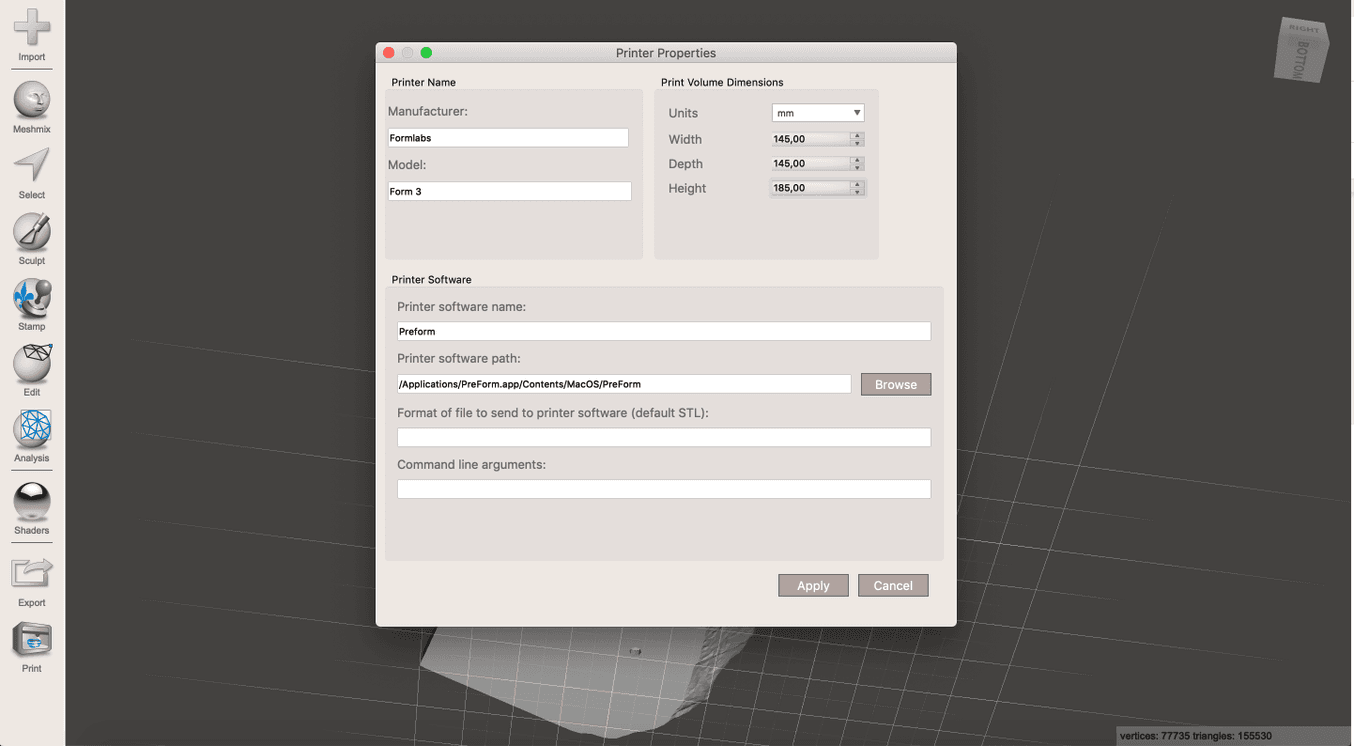
Setting up printer properties in Meshmixer speeds upwards the workflow.
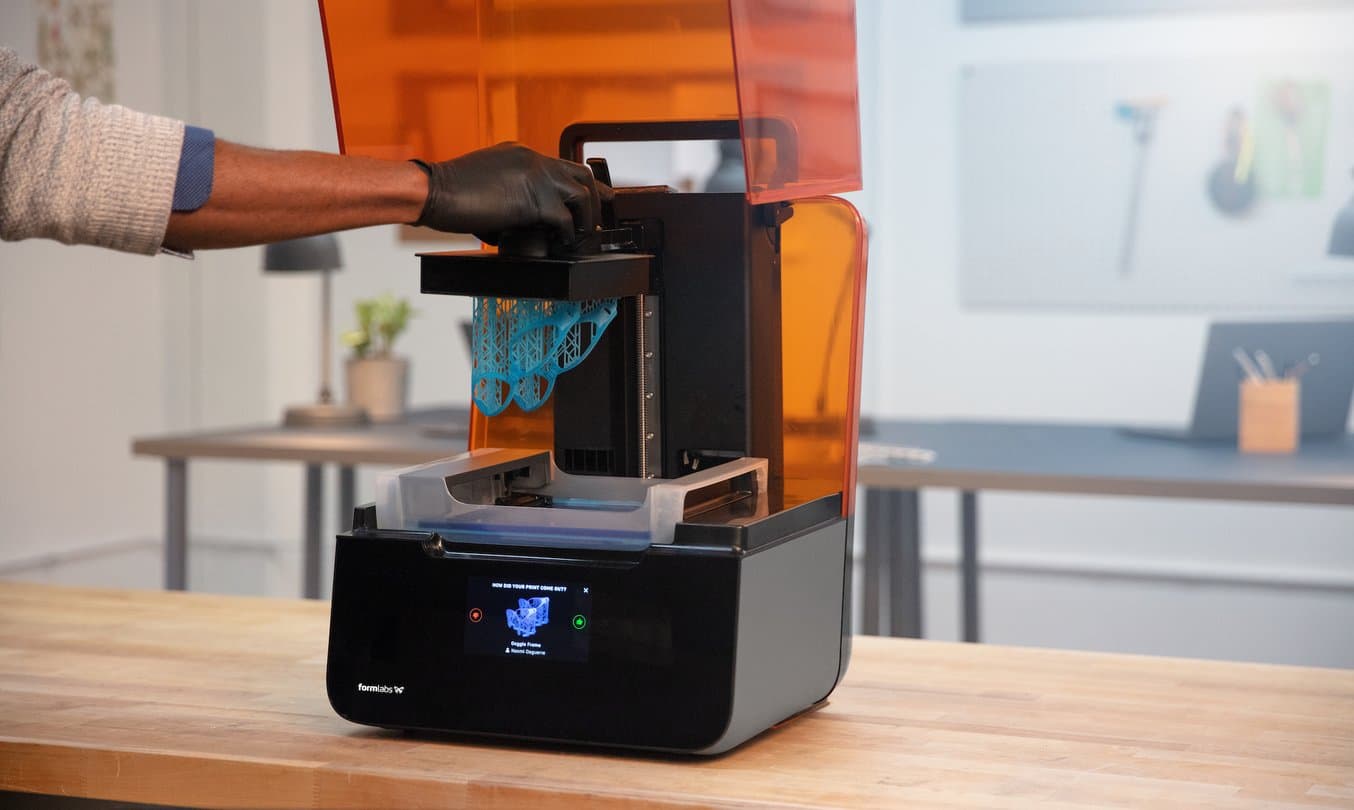
Looking for the right tool to plow your designs into reality? High-resolution desktop stereolithography 3D printers are fast and cost-effective tools to produce high item models with a smoothen surface finish.
Learn more about SLA 3D printers and see the quality immediate by requesting a gratis sample part printed on a Formlabs SLA 3D printer.
Source: https://formlabs.com/blog/meshmixer-tutorial-tips-to-edit-stl-files-for-3d-printing/
0 Response to "low quality drawing to 3d model"
Post a Comment